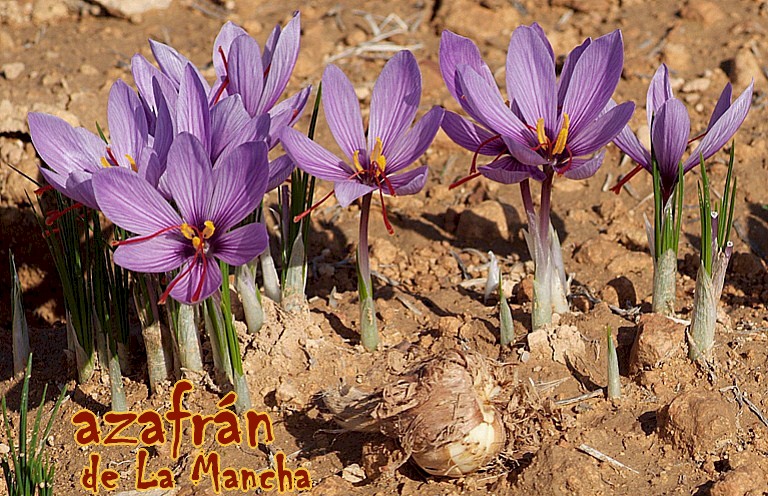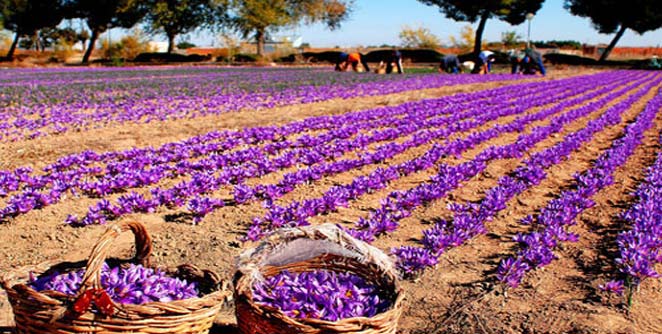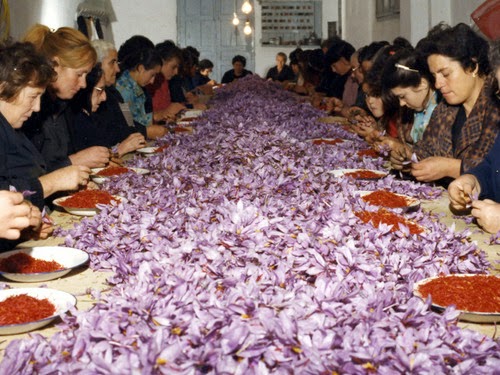Saffron is a tradition that is re-emerging. One of the most expensive products in the world, it is making a comeback in modern cuisine. Pepper, cloves, cayenne... names that invoke flavours and smells that stimulate the senses, that form a part of Spain’s most traditional cuisine and play an essential role in the healthy Mediterranean diet.
Towards the end of October, at dawn in the fields of La Mancha in Spain, one can start to see a surprising carpet of violet-blue. It is the first sign of the ephemeral saffron harvest, the plant Crocus Sativus, that for a period of fifteen days will yield a crop appreciated as much as gold. The flowers are picked manually between dawn and midday around this time of year - beginning of November - with fast twists of the thumb and index finger. Later, specialist workers remove the three fine red filaments at breathtaking speed. Each worker can manipulate between 10,000 and 12,000 flowers per day.
The saffron filaments, or stigmas, are subsequently "toasted" and dried over fire thus accentuating the aroma. They are now ready to be used. The figures concerning the saffron harvest are astonishing: five pounds (2.3 kg) of flowers are needed to obtain five ounces (143 gr) of finished product. In other words, 37 kg of flowers (approximately 70,000 flowers) yield half a kilo of this first class spice. It is not surprising that the farmers can charge €1800 a kilogram for their saffron and this can rise to €3000 on the open market. Without doubt one of the most expensive food products in the world - purple gold.

In their search for spices, men such as Marco Polo and Christopher Columbus set forth in the discovery of new worlds, and in the Middle Ages the so called "Spice Road" was of major economic importance to Old Europe.
Spices are a universe in themselves, and like all universes there is a King, Saffron. Saffron is a product that requires careful elaboration and intensive manual labour, extracting from the heart of the saffron flower (Crocus Sativus Linnaeus) this filament that later, when dried, gives such a delicate flavour.
Saffron is one of the most traditional and natural spices that one can find in Spanish cuisine, and to substitute it for chemical colourings that may be harmful to one's health is a crime, especially as they do not have the flavour and quality of authentic saffron. Amongst the immense variety of spices, saffron is the finest and most delicate. Its singular magic, sensual and inciting, gives unequalled aroma and colour to all gastronomic dishes where it is used. Revered since time immemorial, today saffron is the symbol of the best quality. To bring out the best of the saffron in stews, it should first and foremost be perfectly dry. Then the filaments should be ground in a mortar releasing the full aroma and giving a light red powder
Once ground, add a little stock or liquid from the stew to the mortar and stir. Once well diluted add the saffron to the stew for the latter stages of its preparation. Saffron enriches a wide variety of dishes, adding an appetizing colour and a sumptuous aroma and thus guarantees excellent results.
Saffron in its filament form is the best guarantee of purity. A small quantity of strong clean filaments subsequently ground, add a delicious taste and colour to the widest range of dishes: paellas, stews, soups, pastas, baked fish, potato stews, pasta paellas, oxtail stews, rice dishes, yellow bean stews, prawns, sauces, fish soups - the list is endless.
Saffron is known to both give a healthy appetite and also help with digestion. It has also been attributed with helping to strengthen the heart, the liver and the respiratory tracts. In some parts of Spain saffron is still taken in small doses as an infusion or tea for its medicinal values. It is also used to rub the gums of teething babies to help calm the pains.
The famous Spanish doctor, Andrés Laguna, who worked considerably with saffron filaments, was convinced that taking regular small quantities of the spice lightened the heart. The frequent use of saffron filaments in cooking is due, in part, to the aroma but more importantly the colour it gives to dishes. In so many recipes of the Spanish cuisine it is essential to add a few saffron filaments ground in a mortar.
.jpeg) It is also frequently used in French and Italian dishes and extensively in oriental food. Saffron works so well with fish, meat, pasta and rice, and is used to colour cheeses. As a spice it is found on the market in filament form or ground as a powder. In the form of Filaments ensures that the saffron has not been tampered with. Grind with a little salt in a mortar to release a maximum aroma and colour in the food preparation.
It is also frequently used in French and Italian dishes and extensively in oriental food. Saffron works so well with fish, meat, pasta and rice, and is used to colour cheeses. As a spice it is found on the market in filament form or ground as a powder. In the form of Filaments ensures that the saffron has not been tampered with. Grind with a little salt in a mortar to release a maximum aroma and colour in the food preparation.
Historically saffron has been considered as a luxury product. For this reason it has been the spice that has incited adventure, journeys by sea and by land to the Orient. Many ancient civilizations made perfumes from saffron that were used in religious ceremonies and other occasions. The Romans perfumed their baths with saffron. Its presence signified opulence and refinement and when Nero made his triumphal entrance in Rome as Prince of the Empire, the streets of the city were carpeted with saffron. It was the highest homage that could be paid.
When the Arabs settled in the Spanish Peninsular they introduced the cultivation of saffron, which rapidly became the most abundant spice in Europe.


Saffron harvesting in Castilla, Spain from Mary Adeline Royal